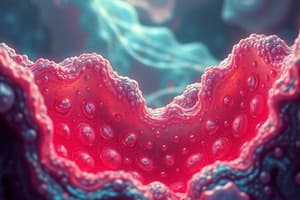Podcast
Questions and Answers
What are the primary characteristics that distinguish epithelial tissues from other tissue types?
What are the primary characteristics that distinguish epithelial tissues from other tissue types?
Epithelial tissues are avascular, cover exterior surfaces, line internal cavities, and form secretory portions of glands.
Explain the significance of the basal lamina in epithelial tissue.
Explain the significance of the basal lamina in epithelial tissue.
The basal lamina is a non-cellular, protein-polysaccharide-rich layer that supports and anchors epithelial cells.
Compare and contrast simple and stratified epithelium.
Compare and contrast simple and stratified epithelium.
Simple epithelium consists of one cell layer, while stratified epithelium has two or more layers.
Describe the function of cuboidal epithelium and where it is typically found.
Describe the function of cuboidal epithelium and where it is typically found.
What makes columnar epithelium distinct in terms of cell shape and function?
What makes columnar epithelium distinct in terms of cell shape and function?
What role does pseudostratified epithelium play in the respiratory tract?
What role does pseudostratified epithelium play in the respiratory tract?
Identify one key function of transitional epithelium and its locations in the body.
Identify one key function of transitional epithelium and its locations in the body.
Differentiate between keratinized and non-keratinized stratified squamous epithelium.
Differentiate between keratinized and non-keratinized stratified squamous epithelium.
What are the distinct surface domains of epithelial cells, and why are they important?
What are the distinct surface domains of epithelial cells, and why are they important?
How do epithelial tissues receive sensory stimuli and where can these specialized cells be found?
How do epithelial tissues receive sensory stimuli and where can these specialized cells be found?
Flashcards
Epithelial Tissue
Epithelial Tissue
A type of tissue that covers the external surfaces of the body, lines internal closed cavities, forms secretory portions of glands, and acts as receptors in certain sensory organs.
Junctional Complexes
Junctional Complexes
Specialized connections between epithelial cells that hold them together in sheets.
Surface Domains
Surface Domains
Distinct regions of an epithelial cell, each with unique characteristics and functions.
Basal Lamina
Basal Lamina
Signup and view all the flashcards
Simple Squamous Epithelium
Simple Squamous Epithelium
Signup and view all the flashcards
Simple Cuboidal Epithelium
Simple Cuboidal Epithelium
Signup and view all the flashcards
Simple Columnar Epithelium
Simple Columnar Epithelium
Signup and view all the flashcards
Pseudostratified Epithelium
Pseudostratified Epithelium
Signup and view all the flashcards
Transitional Epithelium
Transitional Epithelium
Signup and view all the flashcards
Stratified Squamous Epithelium
Stratified Squamous Epithelium
Signup and view all the flashcards
Study Notes
Epithelial Tissue Overview
- Avascular tissue covering exterior body surfaces and lining internal cavities.
- Forms secretory portions of glands and their ducts.
- Comprises receptors in some sensory organs.
Epithelial Cell Characteristics
- Arranged in sheets.
- Possess intercellular junctions (junctional complexes).
- Exhibit distinct surface domains (apical, lateral, basal).
- Properties determined by specific membrane proteins.
- Rest on a non-cellular, protein-polysaccharide-rich basal lamina.
Epithelial Tissue Functions
- Transport: Motile cilia move particles and mucus (trachea, bronchi).
- Sensory Reception: Neuroepithelia (taste buds, retina, nose, ears).
- Lubrication: Secretion of mucous and serous fluids.
- Excretory: Filtering blood, forming urine, and producing sweat.
- Reproductive: Supporting gamete formation (ovaries and testes).
Epithelial Tissue Classification
- Classified by cell arrangement (simple or stratified) and cell shape (squamous, cuboidal, columnar).
- Classification is not based on function.
Simple Epithelium
- Simple Squamous: One layer of flattened cells.
- Lines blood vessels, Bowman's capsule (kidney), and respiratory spaces.
- Function: Exchange, barrier in CNS, lubrication .
- Simple Cuboidal: One layer of cube-shaped cells.
- Found in thyroid follicle walls, kidney tubules, ovary surfaces, and small ducts of exocrine glands.
- Simple Columnar: One layer of elongated cells.
- Lines the digestive tract (stomach to rectum), uterus, and gall bladder.
- Function: Absorption, secretion, barriers.
- Low Columnar: similar columnar , slightly less tall.
Pseudostratified Epithelium
- Appears stratified but is actually simple.
- All cells rest on the basal lamina.
- Found in the respiratory tract (trachea, bronchi, cilia) and epididymis (stereocilia).
Stratified Epithelium
- Stratified Squamous: Multiple layers, superficial layer squamous.
- Keratinized (skin) or Non-keratinized (lining of oral cavity, vagina).
- Function: Barrier protection.
- Transitional: Stratified epithelium that accommodates distension.
- Found in urinary bladder, parts of urethra and ureters, renal calyces.
Epithelial Tissue Staining
- Hematoxylin and eosin (H&E) staining is commonly used.
- Hematoxylin stains dark purple, and eosin stains pink.
Studying That Suits You
Use AI to generate personalized quizzes and flashcards to suit your learning preferences.




